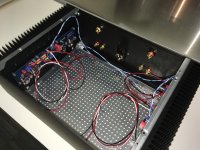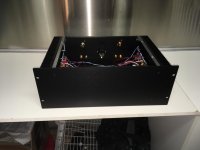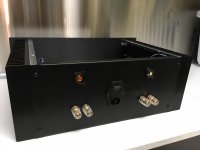Hi NS,
I will definitely look at the soft start option if I have any more issues. I have been using the amplifier for the last two days without any problems so hopefully it won't be necessary. I have to say I am blown away by this amplifier. Thank you to everyone on these boards, the diyaudiostore and, of course, Nelson Pass.
Aaron
I will definitely look at the soft start option if I have any more issues. I have been using the amplifier for the last two days without any problems so hopefully it won't be necessary. I have to say I am blown away by this amplifier. Thank you to everyone on these boards, the diyaudiostore and, of course, Nelson Pass.
Aaron
Hello All,
I'm in the end stages of my Aleph build and have a question about the minimum VA per channel required for an Aleph J. Long story short, when I ordered my transformer I did not specify that I needed a dual 120v primary and dual 18v secondary. So what I've got is a 400VA single 120v primary, and dual 18v secondaries. Having spoken with 6L6 when I first received the transformer, He mentioned that he felt it would still work, and 6L6 even verified how I'd connect the CL60 and capacitor at the mains, which gave me some relief that the custom transformer that I ordered would be ok. However, when I got around to working on the transformer layout in my chassis this weekend I noticed that the printed out specs given with the transformer were as follows:
Secondary:
1. 18v full load, 19v off load, Iac 11.20, output VA 202
2. 18v full load, 19v off load, Iac 11.20, output VA 202
Will those values work? I've read posts that say min 150VA and others that say min 250VA.
Thanks In Advance!
I'm in the end stages of my Aleph build and have a question about the minimum VA per channel required for an Aleph J. Long story short, when I ordered my transformer I did not specify that I needed a dual 120v primary and dual 18v secondary. So what I've got is a 400VA single 120v primary, and dual 18v secondaries. Having spoken with 6L6 when I first received the transformer, He mentioned that he felt it would still work, and 6L6 even verified how I'd connect the CL60 and capacitor at the mains, which gave me some relief that the custom transformer that I ordered would be ok. However, when I got around to working on the transformer layout in my chassis this weekend I noticed that the printed out specs given with the transformer were as follows:
Secondary:
1. 18v full load, 19v off load, Iac 11.20, output VA 202
2. 18v full load, 19v off load, Iac 11.20, output VA 202
Will those values work? I've read posts that say min 150VA and others that say min 250VA.
Thanks In Advance!
Pass DIY Addict
Joined 2000
Paid Member
Though, I am beginning to think I may only have had a fuse issue.
Something still seems "off" to me with your blown fuses... Granted, a large cap bank will draw significant current at startup, though the CL-60 should help protect the fuses and give you a soft start. I would work backward through fuse ratings and use the smallest slow-blow fuse that survives your startup. 5A is quite a bit. See if you can get away with 4A or 3A...
When I find a problem like what you were describing, I like to trouble shoot in a manner that makes things as basic as possible by disconnecting things, making measurements, and then adding back one component at a time. Start with the transformer. Does it provide the voltage out that you are expecting and do the fuses remain intact? Next add the rectifier in. Measure and observe. Then, add a small cap bank. Repeat. Increase the size of the cap bank. Repeat measurements again. By making only one change at a time, you will positively identify where the problem lies.
I had a problem like this years ago that I was able to trace to a metal sliver from drilling and tapping a heat sink that had pierced the silpad insulator that I was using between an output mosfet and the sink. It took a while to find, but process of elimination identified it. Now, I mount mosfets first and measure resistances between all of the pins and the sink before soldering the board to the fets...
This is largely irrelevant, as the North American power grid is 120v. Dual primaries provides the ability for the transformer to run on 120v when they are connected in parallel as well as on 240v when they are connected in series. Building transformers with dual primaries allows the manufacturer to make one model that works in multiple countries. The transformer you have is perfect for your needs.I did not specify that I needed a dual 120v primary
Last edited:
I am troubleshooting the PSU of my Aleph J. .............
Which Country do you live in? And what is your incoming electricity voltage?
Thanks for your reply Eric, that information is very helpful. My concern was that each of the 120v primaries in a dual primary transformer would be 300VA and therefore mine being a single 120v primary would not have the same output that the secondaries needed. Not one of the transformer manufacturers has that info, and my internet searches did not render anything helpful either.
Hi JSA,
The key thing is your transformer has two 18V secondaries each supplying 11.2A. So
2 x (18 x 11.2) ~ 400VA.
Now for the Plitron 300VA dual secondary, 2x18V transformer beloved by millions: ) )
) )
https://shop.plitron.com/shopexd.asp?id=162
Output current is 8.33A for each secondary: So 2 x (18 x 8.33) ~ 300VA
As Eric stated, the dual primary allow flexibility in use in different locations.
FWIW, my DIY A30 uses a single secondary Plitron and my
Aleph-J uses a dual secondary one. Both work fine.
Cheers,
Dennis
The key thing is your transformer has two 18V secondaries each supplying 11.2A. So
2 x (18 x 11.2) ~ 400VA.
Now for the Plitron 300VA dual secondary, 2x18V transformer beloved by millions:
https://shop.plitron.com/shopexd.asp?id=162
Output current is 8.33A for each secondary: So 2 x (18 x 8.33) ~ 300VA
As Eric stated, the dual primary allow flexibility in use in different locations.
FWIW, my DIY A30 uses a single secondary Plitron and my
Aleph-J uses a dual secondary one. Both work fine.
Cheers,
Dennis
Hello,
Are these capacitors ok to use in the supply?
22000UF 63V Aluminum Electrolytic Capacitor 105°C Dimension 35x50mm Cylindrical | eBay
I am tempted by their attractive price/uF
Are these capacitors ok to use in the supply?
22000UF 63V Aluminum Electrolytic Capacitor 105°C Dimension 35x50mm Cylindrical | eBay
I am tempted by their attractive price/uF
You can obtain similar items, some very attractively priced, from Mouser and you won't have to worry about authenticity issues. Why take chances?
All valid points; paying less will bring a fake most certainly: The HK caps have no part number burned on the heat shrinking plastic cover, as specified in UCC datasheets; also the fonts are bolded; and the heat shrinking plastic cover is matte on the originals.
Busted!! thanks for the ultraquick responses.
Busted!! thanks for the ultraquick responses.
Hello All,
So I've finally found enough time to finish my Aleph J project! I'd like to thank all of the members of this great site for all of their help, especially 6L6 for putting together an amazingly easy and well written build guide, and answering my pm's with all of my concerns. I'd also like to thank member Dennis Hui for providing me with the matched Mosfets for the project, and also for his help along the way.
I've powered up the unit with the recommended light bulb test one board at a time and all went well. I've made all of the adjustments for bias and dc offset for the initial warm up and all seems ok so far. The one stand out issue is that the toroidal transformer I ordered is buzzing quite a bit, it can be heard from 4 feet away with the cover on. As I'm still in the warm up and adjustment period I can't tell if the buzzing will come through the speakers since I haven't hooked up any speakers no source to the amp yet. Any thoughts as to what might be causing the buzz, besides the possibility of a defective transformer? All of the voltages at the power supply feeding the boards seem fine at around 25v unloaded.
Pics to come.
Thanks in Advance
So I've finally found enough time to finish my Aleph J project! I'd like to thank all of the members of this great site for all of their help, especially 6L6 for putting together an amazingly easy and well written build guide, and answering my pm's with all of my concerns. I'd also like to thank member Dennis Hui for providing me with the matched Mosfets for the project, and also for his help along the way.
I've powered up the unit with the recommended light bulb test one board at a time and all went well. I've made all of the adjustments for bias and dc offset for the initial warm up and all seems ok so far. The one stand out issue is that the toroidal transformer I ordered is buzzing quite a bit, it can be heard from 4 feet away with the cover on. As I'm still in the warm up and adjustment period I can't tell if the buzzing will come through the speakers since I haven't hooked up any speakers no source to the amp yet. Any thoughts as to what might be causing the buzz, besides the possibility of a defective transformer? All of the voltages at the power supply feeding the boards seem fine at around 25v unloaded.
Pics to come.
Thanks in Advance
Some toroidal's buzz worse than others. The only cure I know of is replacement. Unless it is not fastened to the chassis tightly. You can check AC at the speaker terminals and tell if you will have any noise now before hooking up speakers. Checking for AC and DC at the speaker and input terminals is something I do on every build before plugging up anything. I have had good results with Antek transformers. The last build an F3 used an Antek 400VA 18V one and it has a tiny bit of buzz, nothing that is annoying or can be heard from a foot or two away. Most Antek's I have used are perfectly quiet. A lot depends of current draw of the circuit. You may want to get a higher rated one.
Hello All,
So I've played around a little with the amp this morning to see if I could isolate or lessen the buzz from the transformer. I disconnected one of the secondary leads to one of the bridge rectifiers "A", then powered up the amp only with block "B" and the buzz was gone. I then switched the secondaries with the rectifier blocks they were originally on and the buzz came back. Then finally connected only block "A" and the transformer buzz came back. Could the problem be with the rectifier block? Has anyone had or heard of this problem before?
I used these Fairchild Rectifier Blocks:
http://ca.mouser.com/ProductDetail/...=sGAEpiMZZMtQ8nqTKtFS/LDhWhDI65nslKtwYZS2PGo=
So I've played around a little with the amp this morning to see if I could isolate or lessen the buzz from the transformer. I disconnected one of the secondary leads to one of the bridge rectifiers "A", then powered up the amp only with block "B" and the buzz was gone. I then switched the secondaries with the rectifier blocks they were originally on and the buzz came back. Then finally connected only block "A" and the transformer buzz came back. Could the problem be with the rectifier block? Has anyone had or heard of this problem before?
I used these Fairchild Rectifier Blocks:
http://ca.mouser.com/ProductDetail/...=sGAEpiMZZMtQ8nqTKtFS/LDhWhDI65nslKtwYZS2PGo=
- Home
- Amplifiers
- Pass Labs
- Aleph J illustrated build guide



